Latent (unsaturated) iron-binding capacity of blood serum
The maximum amount of iron that transferrin can attach to its complete saturation is called the total iron binding capacity of the serum (TIBC). TRI correlates with serum transferrin levels, but the relationship between them is nonlinear and is disrupted in diseases that affect the binding capacity of transferrin and other iron-binding proteins. The additional amount of iron that can bind to transferrin is the unsaturated (latent) serum iron-binding capacity (IBC). Thus, the OISS represents the sum of two terms: the iron-saturated part of transferrin (iron content in serum) and the unsaturated part (IUS):
TISS = Serum iron + NISS The ratio of the amount of iron associated with transferrin to TISS gives an idea of the coefficient (degree) of transferrin saturation: Saturation coefficient, % = Serum iron / TISS * 100
Indications for the study
- Diagnosis of iron deficiency conditions;
- diagnosis of anemia;
- chronic blood loss;
- gastrointestinal diseases;
- severe illnesses accompanied by significant loss or increased protein intake;
- systemic connective tissue diseases, severe chronic diseases.
Research method.
When determining the TLC, excess ferric iron is added to the patient’s blood sample, and the ions remaining in the serum after transferrin saturation are precipitated with magnesium carbonate. The concentration of total iron, determined by the colorimetric method in the supernatant, reflects the value of the total iron content.
When determining NVSS, a solution of divalent iron salt is added to the patient’s blood serum. Excess iron remaining in the serum after transferrin saturation is determined by reaction with chromogen using a colorimetric method. NISS is calculated as the difference between the total amount of iron ions added to the sample and the amount of iron ions determined during the reaction, i.e., not bound by proteins.
Increased values
- Iron deficiency conditions:
- chronic blood loss;
- insufficient intake of iron from food;
- impaired iron absorption caused by gastrointestinal diseases;
- increased utilization and consumption of iron (late pregnancy, active growth).
Reduced values
- Severe diseases accompanied by significant loss or increased protein intake: nephrotic syndrome;
- chronic renal failure;
- severe burns;
- chronic infections and active inflammatory processes;
- severe liver diseases with disruption of its protein-synthetic function;
Latent iron binding capacity of serum
The latent iron-binding capacity of serum is a laboratory indicator that reflects the potential ability of blood serum to bind additional amounts of iron.
Synonyms Russian
Unsaturated iron-binding capacity of serum, NISH, LVSS.
English synonyms
Iron indices, iron profile, unsaturated iron binding capacity, UIBC.
Research method
Colorimetric photometric method.
Units
μmol/L (micromoles per liter).
What biomaterial can be used for research?
Venous blood.
How to properly prepare for research?
- Do not eat for 8 hours before the test; you can drink clean still water.
- Stop taking medications containing iron 72 hours before the test.
- Avoid physical and emotional stress and do not smoke for 30 minutes before the test.
General information about the study
Iron is an important trace element in the body. It is part of hemoglobin, which fills red blood cells and allows them to carry oxygen from the lungs to organs and tissues.
Iron is part of the muscle protein myoglobin and some enzymes. It is absorbed from food and then transferred by transferrin, a special protein that is formed in the liver.
Usually the body contains 4-5 g of iron, about 3-4 mg (0.1% of the total) circulates in the blood “in conjunction” with transferrin. The level of transferrin depends on the functioning of the liver and on the person’s diet. Normally, 1/3 of the transferrin binding centers are filled with iron, the remaining 2/3 remain in reserve. The serum latent iron binding capacity (SIBC) reflects how much transferrin is “unfilled” with iron.
This parameter can be calculated using the following formula: LVSS = TGSS - iron in serum (TGSS is the total iron-binding capacity of blood serum - an indicator characterizing the maximum ability of transferrin to “fill up” with iron).
With iron deficiency, there is more transferrin so that this protein can bind to the small amount of iron in the serum. Accordingly, the amount of transferrin “not occupied” by iron increases, that is, the latent iron-binding capacity of the serum.
On the contrary, with an excess of iron, almost all transferrin binding centers are occupied by this trace element, therefore the latent iron-binding capacity of the serum decreases.
The amount of serum iron can vary significantly from one day to the next and even within one day (especially in the morning), however, the PVSS and LVSS normally remain relatively stable.
In the early stages, iron deficiency sometimes does not show any symptoms. If a person is otherwise healthy, then the disease can make itself felt only when hemoglobin decreases below 100 g/l. Usually these are complaints of weakness, fatigue, dizziness, and headaches.
What is the research used for?
To determine the amount of iron in the body and its relationship with blood proteins (together with a test for iron in serum, sometimes with a test for PVSS and transferrin). These studies make it possible to calculate the percentage of transferrin saturation with iron, that is, to determine exactly how much iron the blood carries. This indicator most accurately characterizes iron metabolism.
The purpose of such tests is to diagnose iron deficiency or excess. In patients with anemia, they can help determine whether the disease is caused by iron deficiency or other causes, such as a chronic disease or vitamin B12 deficiency.
When is the study scheduled?
- When any abnormalities are detected in the general blood test, analysis of hemoglobin, hematocrit, number of red blood cells (together with a test for iron in serum).
- If you suspect a deficiency or excess of iron in the body. With a severe lack of iron, shortness of breath, pain in the chest and head, and weakness in the legs occur. Some people have a desire to eat unusual foods (chalk, clay), a burning sensation on the tip of the tongue, and cracks in the corners of the mouth. Children may have learning difficulties.
- If you suspect iron overload (hemochromatosis). This condition manifests itself in different ways, such as joint or abdominal pain, weakness, fatigue, decreased sexual desire, and irregular heart rhythm.
- When monitoring the effectiveness of treatment for iron deficiency or excess.
What do the results mean?
Reference values: 20 - 62 µmol/l.
Interpretation of the results of analysis for LVSS, as a rule, is made taking into account other indicators that assess iron metabolism.
Reasons for increasing the life insurance ratio
- Anemia. It is usually caused by chronic blood loss or insufficient consumption of meat products.
- Third trimester of pregnancy. In this case, serum iron levels decrease due to increased iron requirements.
- Acute hepatitis.
- Multiple blood transfusions, intramuscular iron administration, inadequate administration of iron supplements.
Reasons for the decrease in life insurance
- Chronic diseases: systemic lupus erythematosus, rheumatoid arthritis, tuberculosis, bacterial endocarditis, Crohn's disease, etc.
- Hypoproteinemia associated with absorption disorders, chronic liver disease, burns. A decrease in the amount of protein in the body leads, among other things, to a drop in the level of transferrin, which reduces the life span.
- Hereditary hemochromatosis. In this disease, too much iron is absorbed from food, the excess of which is deposited in various organs, causing them to become damaged.
- Thalassemia is a hereditary disease in which the structure of hemoglobin is changed.
- Cirrhosis of the liver.
- Glomerulonephritis is inflammation of the kidneys.
What can influence the result?
- Estrogens and oral contraceptives lead to an increase in LVSS.
- ACTH, corticosteroids, testosterone can reduce LVSS.
- The amount of serum iron can vary significantly from day to day and even within one day (especially in the morning), however, the PVSS and PVSS normally remain relatively stable.
Important Notes
- Total serum iron-binding capacity (TIBC) is calculated as the sum of TIBC and serum iron.
- When there is a lack of iron, its level falls, but the LVSS increases.
Also recommended
- Serum iron
- Iron binding capacity of serum
- Ferritin
- Transferrin
- Hemoglobin
- Hematocrit
- Red blood cells
Who orders the study?
General practitioner, therapist, hematologist, gastroenterologist, rheumatologist, nephrologist, surgeon.
Iron binding capacity of serum
Serum iron binding capacity (IBC) is an indicator that reflects the amount of iron that the blood can carry.
Synonyms Russian
Total iron binding capacity of serum, TIBC.
English synonyms
Iron indices, iron profile, TIBC, total iron binding capacity, iron binding capacity, IBC, serum iron-binding capacity.
Research method
Kinetic colorimetric method.
Units
μmol/L (micromoles per liter).
What biomaterial can be used for research?
Venous blood.
How to properly prepare for research?
- Do not eat for 8 hours before the test; you can drink clean still water.
- Avoid physical and emotional stress 30 minutes before the test.
- Do not smoke for 30 minutes before the test.
General information about the study
Iron is an important trace element in the human body. It is part of hemoglobin, which fills red blood cells and allows them to carry oxygen from the lungs to organs and tissues. Iron is part of the muscle protein myoglobin and some enzymes. It is absorbed from food and then transported throughout the body by transferrin, a special protein that is formed in the liver.
Normally, the body contains 4-5 g of iron, about 3-4 mg (0.1% of the total amount in the body) circulates in the blood “in conjunction” with transferrin. The amount of transferrin depends on the functioning of the liver and the person’s diet. Normally, 1/3 of the transferrin binding centers are filled with iron, the remaining 2/3 remain in reserve. To determine the total iron-binding capacity of blood serum, a certain amount of iron is added to the test serum until all transferrin binding centers are filled. The total amount of iron bound to transferrin is then measured. It characterizes the degree of serum iron deficiency and actually reflects the amount of transferrin in the blood.
With iron deficiency, there is more transferrin in the body so that this protein can bind to the small amount of iron in the serum. Accordingly, transferrin “unoccupied” by iron, that is, the latent iron-binding capacity of the serum, also increases.
On the contrary, with an excess of iron, almost all transferrin binding centers are occupied by this trace element, therefore the latent iron-binding capacity of the serum decreases.
The amount of serum iron can vary significantly from one day to the next and even within one day (especially in the morning), however, the normal life-value level remains relatively stable.
What is the research used for?
The TBI test is usually prescribed in conjunction with serum iron levels, sometimes with serum latent iron binding capacity and transferrin tests to determine the amount of iron in the body and its association with blood proteins. These studies make it possible to calculate the percentage of transferrin saturation with iron, that is, to determine exactly how much iron the blood carries. This indicator most accurately characterizes iron metabolism.
The purpose of such tests is to diagnose iron deficiency or excess. In patients with anemia, they can determine whether the disease is caused by iron deficiency or other causes, such as a chronic disease or vitamin B12 deficiency. Interestingly, when there is a lack of iron, its level drops, but the life-saving value increases.
These tests are also performed if iron poisoning or hereditary hemochromatosis, a disease associated with increased absorption and accumulation of iron in the body, is suspected. With it, the concentration of iron in the serum increases, and the life-saving blood value decreases or remains normal.
When is the study scheduled?
- When any abnormalities are detected in the general blood test, analysis of hemoglobin, hematocrit, number of red blood cells (together with a test for iron in serum).
- If you suspect iron deficiency or excess.
- In the early stages, iron deficiency may not show any symptoms. If a person is otherwise healthy, then the disease can make itself felt only when hemoglobin decreases below 100 g/l. Usually these are complaints of weakness, fatigue, dizziness, and headaches.
- With a severe lack of iron, shortness of breath, pain in the chest and head, and weakness in the legs occur. Some people have a desire to eat unusual foods (chalk, clay), a burning sensation on the tip of the tongue, and cracks in the corners of the mouth. Children may have learning difficulties.
- OZHS and other tests reflecting iron metabolism may be prescribed if the body is suspected of overloading with iron (hemochromatosis). This condition manifests itself in different ways, such as joint or abdominal pain, weakness, fatigue, decreased sexual desire, and irregular heart rhythm.
- When monitoring the effectiveness of treatment for iron deficiency or excess.
What do the results mean?
Reference values: 45.3 - 77.1 µmol/l.
Interpretation of the results of the analysis on the life cycle is usually carried out taking into account other indicators that assess iron metabolism.
Reasons for increasing the life insurance ratio
- Anemia is the most common cause of low iron levels. It is usually caused by chronic blood loss or insufficient consumption of meat products.
- Third trimester of pregnancy. In this case, serum iron levels decrease due to increased iron requirements.
- Acute hepatitis.
Reasons for the decrease in life insurance
- Chronic diseases: systemic lupus erythematosus, rheumatoid arthritis, tuberculosis, bacterial endocarditis, Crohn's disease, etc.
- Hypoproteinemia associated with absorption disorders, chronic liver disease, burns. A decrease in the amount of protein in the body leads, among other things, to a drop in the level of transferrin, which reduces the life span.
- Hereditary hemochromatosis. In this disease, too much iron is absorbed from food, the excess of which is deposited in various organs, causing them to become damaged.
- Thalassemia is a hereditary disease leading to anemia, in which the structure of hemoglobin is changed.
- Cirrhosis of the liver.
- Glomerulonephritis is inflammation of the kidneys.
- Multiple blood transfusions, intramuscular iron administration, inadequate dosage of prescribed iron supplements.
What can influence the result?
- Estrogens and oral contraceptives lead to an increase in life-span.
- ACTH, corticosteroids, testosterone can reduce CVV.
Important Notes
- The amount of serum iron can vary significantly from one day to the next and even within one day (especially in the morning), however, the normal life-value level remains relatively stable.
- The level of transferrin can be calculated using the formula: 0.8 x TBL - 43. However, the relationship between TBL and transferrin is not linear and may not be observed in diseases that affect the binding capacity of transferrin.
Also recommended
- Serum iron
- Latent iron binding capacity of serum
- Ferritin
- Transferrin
- Hemoglobin
- Hematocrit
- Red blood cells
Who orders the study?
General practitioner, therapist, hematologist, gastroenterologist, rheumatologist, nephrologist, surgeon.
Total serum iron binding capacity (TIBC) (includes determination of iron, TIBC)
Total iron binding capacity of serum (TIBC) is a calculated parameter that reflects the amount of iron that can be transported by blood throughout the body.
Iron entering the body is absorbed mainly in the intestinal tract and temporarily accumulates in cells in the form of ferritin. Ferritin provides a soluble protein shell to store the complex of insoluble iron(III) hydroxide and iron(III) phosphate. If necessary, iron is released into the blood and distributed throughout the body using transferrin.
Typically only 25-30% of transferrin is saturated with iron. The additional amount of iron that can be bound is the latent iron binding capacity (IBC). Total iron binding capacity (TIBC) can be indirectly determined using the sum of serum iron and TIBC.
Serum iron, total iron-binding capacity, and percent transferrin saturation are widely used to diagnose iron deficiency, but these values may vary in other body conditions.
In what cases is research usually prescribed?
- for symptoms of iron deficiency;
- when monitoring patients undergoing treatment for iron deficiency;
- in case of deviations from the norm in the general blood test;
- if hemochromatosis or iron overload is suspected.
What exactly is determined during the analysis process?
OZHS is a calculated indicator for which the level of iron and transferrin in the blood is measured and the latent iron-binding capacity is calculated.
What do the test results mean?
The results of the analysis are usually evaluated together with other indicators of iron metabolism. An increase in PVSS values may indicate iron deficiency anemia, late pregnancy (due to increased transferrin and decreased iron levels), acute hepatitis.
A decrease in life-sustaining lifespan is possible in the following conditions:
- lack of protein-synthesizing function of the liver (for example, with cirrhosis)
- autoimmune and rheumatic diseases;
- hereditary hemochromatosis;
- thalassemia is a genetic disease in which the structure of hemoglobin changes;
Test deadlines.
Usually the test result can be obtained the next day after the blood is drawn.
How to prepare for the analysis?
You should adhere to the general rules of preparation for taking blood from a vein. Detailed information can be found in the corresponding section of the article.








